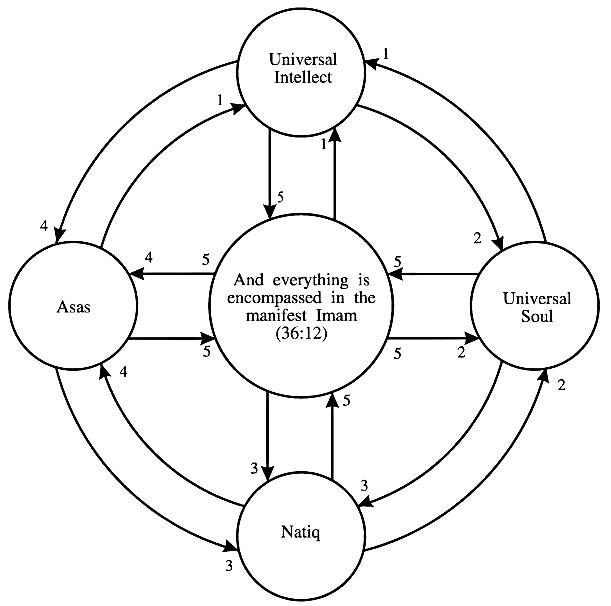Chain of the Light of Imamat - Explanation of the Face of God (Wajhu'llah)
Explanation of the Face of God (Wajhu'llah)
Tags: Face of God, Wajhu'llah, Diagrams
The Holy Prophet has said: "He who has seen me, has seen God". It is necessary to reflect for a while on what kind of wisdom is in the depth of this Hadith and how our intellect can understand it. In truth, man by himself is nothing until the Lord of ta'wil helps him. Therefore, seeking favour from the Treasure of realities, namely, the Lord of ta'wil, we try to mention here a drop from the unfathomable ocean of the extraordinarily vast meanings of this wisdom-filled Hadith, that seeing or didar is of three kinds: by the right eye, by the left eye and with both eyes. If you are asked which is the best way of seeing, then immediately, you will say: "with both eyes". This is only an example or a symbol. The meaning (mamthul) of this example is that by the right eye is meant the physical didar, by the left eye the spiritual didar and by both eyes, both the physical and spiritual didar. That is, he who saw the Prophet only in his physical aspect, he in reality closed the left eye, and he who saw him in his spiritual status, he in reality closed the right eye, and he who saw him in both aspects, the physical and spiritual, kept both his eyes open.
Now I would like to say that in every case, the didar has two purposes, namely for beauty and for recognition. Both in the luminous and in the physical states, beauty and recognition result in attraction and struggle and this happens because the face, more than any other part of the body, has all the human attributes. The Holy Prophet in the light of the wisdom of this Hadith, can be considered to have told the wise: I am the Face of God both in the physical and spiritual sense, therefore, my didar is the didar of God, my beauty is the beauty of God, my recognition is the recognition of God, he who saw me, but could not recognise me, remains in great loss. For the Hadith of the Holy Prophet: "He who has seen me, has seen God", in addition to many other meanings, also urges one to yearn for didar. Further, from the depth of this Hadith, appears the importance of the recognition of, obedience to and love for the Prophet and the Imam. In short, this Hadith shows that the Prophet was the Face of God, and when he was the Face of God, then he was also His tongue, eyes, ears, etc. There is no doubt for mu'mins that the Prophet of mercy was the Face of God and His didar in his time. Similarly, Mawlana `Ali in one of his khutbahs says: "I am the Face of God (Ana wajhu'llah)". We are sure that God has the same Face and it is always in this world. The person through whom the recognition of God is attained is the Face of God and such a person is the Prophet and the Imam in their respective times. Since the Face of God is imperishable, therefore, the Imam of the time is always living and present in this world, for as God says in the Glorious Qur'an: "Everything is perishable save His Face. His is the command and unto Him you will be brought back" (28:88).
By exempting His Face, after mentioning the perishability of everything, it reveals that, in a sense, His Face is included in other things and is in this world, where there are perishable things. For the mention of "save" (illa) after "everything" (kulla shay'in) is a decisive proof that "His Face" (wajhahu) is from the genus of things and is in the world of things. Further, some people have doubts about the perishability of the face, therefore, He declares His Face to be imperishable. This perishability of things was only their physical death, then from the results of the command, judgement and returning to Him, it becomes clear that all human beings die and after the judgement, they are brought back to the Return (ma`ad). But the Face of God which is the Imam of the time, is always in this world, living and imperishable, although apparently he is also from the genus of the human beings, who at the end of their fixed time, perish. But the Imam of the time, due to the characteristic of being the Face of God and His light, differs from the rest and is always living and present in this world by changing his physical attire. The proof of this is in the wisdom-filled verse that the relation of the Face of God, in a sense is with all perishable things due to which God has mentioned it among all things, but in another sense, it has no relation with them due to which God has excepted it from the rest. The first relation is common and the second is special. For there is nothing in the world, other than the Face of God, which has all the attributes mentioned in this verse. The first characteristic is to deserve to be called the Face of God with all His attributes. The second characteristic is to live among the mortals with respect to physical relations and bring them closer to himself. The third characteristic is to bring them closer to light and immortality as a result of physical closeness, as God says: "He knows that which goes down into the earth and that which comes forth from it. He is the Merciful, the Forgiving" (34:2; 57:4); "By the heaven full of ways" (51:7); "Indeed, there has come to you a light and a manifest Book from Allah; whereby Allah guides him who follows His Rizwan into the ways of ta'yid (spiritual help) and brings them out of darknesses unto light by His decree and guides them on the right path" (5:15-16).
Diagram of Oneness of Usul by Their Circular Act

- Return to Universal Intellect
- Return to Universal Soul
- Return to Natiq
- Return to Asas
- Return to Imam-i Mubin
| Chapter Index | Previous Chapter | Next Chapter |
